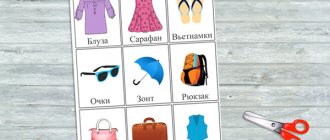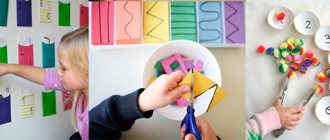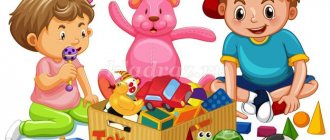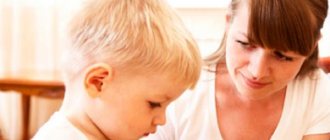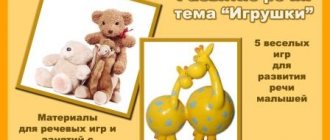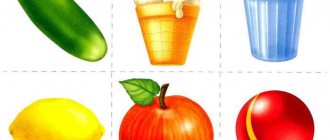Toys for speech development of babies up to 1 year old
Pyramid (from 6 months). A correct pyramid must meet the following requirements:
- The first pyramid should have no more than 5 rings.
- The pyramid rod must have the same thickness along its entire length.
- The size of the holes in all rings should be the same.
- The pyramid must have a stable base.
- For children over one year old, all pyramid rings must have the same color.
With the help of a pyramid, the baby will develop motor skills, which have a huge impact on speech development. Master the concepts of “big - small”. In addition, he will master sorting, basic comparison skills, counting, and become familiar with primary colors.
Balls (from 6 months). A variety of sizes, colors and properties (smooth and pimply, hard and soft, heavy and light) is desirable. Balls are great for a child's physical development. In addition, they perfectly contribute to the development of thinking. With their help, you can teach your child to compare, classify, study colors, sizes, and practice a vocabulary of adjectives.
Cubes (from 7 months). The set should consist of different shapes: cube, brick, prisms, cylinders. These details are good material for the development of thinking, imagination, and fantasy. An older child can build entire cities and write stories about them, which is an excellent tool for developing coherent speech. Using a set of cubes, you can get acquainted with mathematics: study counting, shapes, and magnitude.
Car on a string (from 7 months). By simply pulling a toy by the string, the child first develops a conclusion about cause-and-effect relationships. At the age of 8 months, a dump truck is needed - the baby turns the wheels, learns to drive the car, avoid obstacles, carry various objects in the back and unload them, and roll his favorite toys. Thus, the child develops spatial concepts and practices prepositions and prefixes.
Doll (from 8 months). An ordinary doll is necessary for all children, regardless of gender. Since she is a projection of a person in the toy world. With the doll, the baby learns to show and name parts of the body; with it, you can play out various routine moments and everyday situations. This is how the baby first realizes his place in the world around him and his personality develops. By playing with a doll, you can expand your vocabulary of nouns on various topics, learn verbs, study body parts, and items of clothing.
How to choose educational toys for children over 3 years old
When choosing educational toys for children over 3 years old, it is important to consider certain criteria:
- Aesthetic appeal . The toy should evoke positive emotions and foster good feelings. It is advisable to choose bright and rich colors.
- Benefit . A toy can promote physical development, help broaden one's horizons, or improve fine motor skills. When choosing, it is important to consider the benefits that the toy will bring to the child.
- Simplicity . You should not buy multifunctional toys that will be difficult for your child to understand. Adults think that this way the child will develop faster, but this opinion is wrong. It is better to purchase several separate toys that are understandable to the baby.
- Safety . You should not choose toys with small parts that a child can swallow. Also, the product should not have sharp corners.
- Quality . Toys must have special marks: PCT marking - Russian standard or EAC - safety mark of the Eurasian Economic Union. Such icons indicate the environmental friendliness of the product. Therefore, the risk of allergic reactions is reduced.
Toys for children's speech development after 1 year
Matryoshka. In terms of its purpose, a nesting doll is similar to a pyramid, but on a more complex level. Simple manipulations with a nesting doll are accessible even to a child. As you get older, there are more and more options for playing with matryoshka dolls. It helps in mastering ordinal numbers, comparative forms of adjectives, and prepositions.
Musical instruments (xylophone, drum, tambourine). Instruments are necessary to develop a sense of rhythm. Tapping a rhythm and performing movements to a given rhythm plays an important role in the formation of speech processes, in particular, phonemic hearing. Musical instruments will be useful in theatrical performances, as well as in role-playing games.
Sorter. With its help, the child learns to correlate three-dimensional figures in shape and size with their flat image. Logic, visual memory, thinking, and fine motor skills develop. The first sorter should have no more than three holes of simple shapes. If there are too many of them, it is difficult for the child to complete the task, and he does not receive satisfaction from the game. When the child learns to cope with a simple sorter, you can increase the number of holes and the variety of shapes.
Insert frames . It is desirable that the elements are the same color and are evenly inserted into place. The child will recognize figures by their contours to form visual images of them. When choosing inserts, you need to pay attention to ensure that you cannot insert the figure incorrectly. When the child can correctly determine the place of the insert in the frame, you can try inserting the figures with their eyes closed, thereby developing tactile sensations, imaginative thinking, and coordination. Speech development occurs: the child first understands and then pronounces independently who or what is in front of him, what properties he has, what actions this item or object can perform. Elements of the inserts can be used in theatrical games and in practicing individual aspects of speech.
Dishes . The process of eating has an important place in people's lives; the strongest feelings are associated with it - hunger and satiety. A significant portion of time is spent on food, so it is important to pay due attention to playing with dishes. In the process of eating, a story game develops, which is a powerful stimulus for the development of speech and thinking. Playing with children's dishes perfectly engages fine motor skills and actively develops sensory sensations. This game promotes the formation of logical operations and develops the skill of simple arithmetic operations.
Figures of animals and people . They allow you to reproduce the real world in the game. The child creates a game world and fills it with characters. This is not only a game, the figures are an ideal aid for development. We cannot do without speech - we name the characters, tell stories about them. By naming animal body parts, you can practice possessive adjectives and write descriptive stories. Animals can be classified according to their mode of movement, habitat, and appearance. When simulating real actions, coherent speech is formed, thinking, imagination, and fantasy develop.
Editor's Choice
Play-Doh “Cookie Shop”
Play-Doh Cookie Shop Modeling
helps baby develop finger strength and promotes fine motor skills, imagination and concentration. The mass is easy to clean and gets dirty a little, its consistency is soft for children's hands. In addition to motor skills, perseverance, accuracy and determination are developed. Thanks to the various tools included in the kit, the child will be able not only to sculpt figures, but also to use all his imagination.
You can play role-playing games, where the baby will be the cook and the parents will be the “tasters.” The modeling mass quickly hardens in air, so after playing it needs to be put away in jars or allowed to harden and play, as with full-fledged toys created with your own hands.
The editors consider the toy to be the best in the rating. It is suitable for any child and develops the necessary skills. Also, the made figures can be played in the future, which saves the family budget.
Main characteristics:
| Type | modeling mass |
| Solidifying | Yes |
| Number of colors | 5 |
| Weight | 280 g |
| Equipment | 5 jars of plasticine, press syringe, spatula, tray with molds, 4 separate molds, rolling pin with patterns and saucer, illustrated instructions |
Advantages and disadvantages
Develops fine motor skills and imagination, teaches how to use tools
Not suitable for creating complex shapes; hardens quickly in air
show more
Article:
Activation of speech imitation.
The problem of delayed speech development, among other things. and among non-speaking children, it is becoming increasingly relevant. The child’s speech development must go through all stages of speech: at 2-3 months – humming (sounds “k”, “x”...); at 6-8 months - babbling (pa-pa-pa, ma-ma-ma-ma...); at 1 year - about 10 words (av-av, give, na, mom, dad, ...); by the age of 2, the active vocabulary (this is when the child pronounces these words) is already about 300 words; and at 3 years old it reaches 1,000 words.
What to do if a child has practically no speech by the age of 3-5 (“speaks” about 10 incomprehensible words)?
1. Urgently contact a speech therapist.
2. If there is no specialist, start the work yourself and “talk” to the children.
The crucial point in working with speechless children will be to create the need to imitate the words of an adult. This can manifest itself in any sound complexes. Therefore, it is necessary to create conditions in which the child would have a desire to pronounce (repeat) the same sound combinations repeatedly.
1. At the request of an adult, the child imitates sounds. The cries of birds and animals: “av”, “mu”, “ko-ko”, etc.; the chain of these onomatopoeia lengthens to 3-4 syllables: “av-av-av” (imitates the barking of a dog) or “ko-ko-ko” (imitates the cackling of a chicken."
During this period of speech development, children can name toys, familiar objects, actions performed by them or their loved ones, and also express their desires or reluctances in a sound form accessible to them. During this period, you cannot demand from the child the correct pronunciation of words, the correct sound pronunciation, the main thing is that he speaks, even if the child reproduces at least part of the words by imitation.
Activating children's speech or inducing speech imitation should be closely connected with the child's practical activities, with play, with a visual situation, which should be achieved under various but mandatory conditions: emotionality of contact with the child, a certain level of understanding of speech, stability of attention. The presence of imitative motivation. Much will depend on how interesting the games are, how deeply the positive emotions of non-speaking children are affected, and how inventive the adults are.
To achieve the desired effect in activating imitative speech activity, one must begin with the development of imitation in general: “Do as I do.” It is necessary to teach children to imitate actions with objects (for example, playing ball), teach them to imitate the movements of arms, legs, and heads (“Let’s fly like birds”; “Let’s stand on one leg,” etc.).
2. You can perform breathing and vocal exercises to lengthen speech exhalation.
For this purpose, children are invited to smell flowers, warm their hands, blow a soap bubble, etc.; draw out the sounds “a-a-a-a” (the girl is crying), “o-o-o” (the trumpet is humming), “ay” (the children are lost), “i-i-i” (the mouse is crying), “wa "(Lalya cries), "oh-oh-oh" (bitten by a wasp).
3. Do lip exercises. For example, make a straw; stop the horse (“whoa”); alternately stretch your lips into a tube and then show your teeth.
4. Do exercises for the tongue. For example: licking lips; show how a cat laps milk; give “injections” in each cheek; “brush” your teeth with your tongue; click your tongue.
It is advisable to carry out game techniques that combine breathing exercises, movements and pronouncing individual sounds and syllables.
An adult reads the text. And the children perform the appropriate movements and pronounce individual sounds and syllables.
"Small house, big house"
Adult. The bear has a big house, oh, oh, oh (they spread their arms to the sides)
Children (angrily). Oh, oh, oh (raise your hands up)
Adult. And the hare’s is small, ah, ah, ah (plaintively)
Children (complainingly). Ay, ay, ay... Children squat and exhale. Lower your head and cover your knees with your hands.
Adult. Our bear went home (the children waddle).
Children (angrily). Oh oh oh.
Adult. And a little bunny.
Children (jump on two legs). Ah ah ah.
5. Induce amorphous words in the child, i.e. the child pronounces words, onomatopoeia, as he knows how, as he succeeds.
Sound combinations are selected based on the child’s capabilities. In some children, labial sounds are easier to evoke (“ba-ba”, “mu-mu”), in others - posterior palatal sounds (“ka-ka”, “ha-ga”), in others – anterior palatal sounds (“di-di”, “ ti-ti").
Successful sound complexes must be repeated in a playful way with the child several times (up to 5-6 repetitions). Pronounce these sound combinations: sometimes quietly, sometimes loudly; sometimes slowly, sometimes quickly; sometimes angrily, sometimes tenderly, sometimes affectionately. Inducing speech imitative activity is good to combine with breathing, vocal and articulation exercises. It is better to give articulation exercises only in a playful way.
1) The names of persons close to the child: mother (“ma”), dad (“pa”), woman (“ba”), uncle (“dya”), aunt (“tya”, “t”).
2) Names of close persons or toys, dolls: Olya (“o”, “oya”), Nina (“ni”), Vova (“ova”, “va”).
3) Requests: give, na (“dya”, “nya”), where (“de”), there (“tya”), here (“de”). Expressing a desire to repeat something again: more (“iso”; “sho”).
4) Expressing one’s state with interjections “ay”, “oh” (it hurts), “shhh” (quieter).
5) Imitation of animal cries: dogs - aw-aw, am-am (“af”); cows - mu-mu ("u"), donkey - ia.ia ("a"), cats - meow-meow ("ay", "miyau"), goat - be-be "("pee-pee") .
6) Imitation of screams, squeaks: mosquito - i-i-i, birds - pi-pi-pi or ti-ti-ti (“and”, “ti”), cuckoos - ku-ku-ku (“uku”) ; chickens - ko-ko-ko, ko-ko-ko (“eye”); frogs - kva-kva-kva (“va-va”), tyap-tyap (“yap”).
7) Calling animals and controlling animals: cat - ks-ks-ks or kitty-kis-kis; scatter (“beat”); control of the horse - but (let's go), pru (stopped); call the chickens - tip-tip-tip or chick-chick-chick.
 Imitation of musical toys: pipe - doo-doo-doo (“du”); balalaika – la-la-la (“I”); to the bell - bom-bom-bom (“om-oh”).
Imitation of musical toys: pipe - doo-doo-doo (“du”); balalaika – la-la-la (“I”); to the bell - bom-bom-bom (“om-oh”).
9) Imitation of traffic noises: car - beep, beep, di-di; to the plane - ooh-ooh (in a low voice); steam locomotive - tu-tu.
10) Imitating the noise produced by an object when falling - bang or bang (“ah”, “wah”); the sounds of footsteps - top-top-top (“op-op”), the sound of a hammer - knock-knock (“toot-too”); drops of water - drip-drip.
11) Emotional exclamations: ah, oh, oh-uh (“uh”).
6. Invite children to name their toys, familiar objects (or object pictures); Distortions and substitutions of sounds are acceptable.
Approximate lexical material
Pussy, bunny, bear, fish, goat, dog, Petya, squirrel, fox, donkey.
Ball or ball: (“agi”), mushroom or fungus (“gt”), house or hut (“omi”), cube (“ku”), car (“sina”), airplane (“ate”), steamship ( hunt").
Note. To activate speech, we recommend using shopping games (children buy toys, objects) “Find out a new toy” 9 children name a toy that suddenly appears that was hidden from him), “arrange the toys as I say, and then name them yourself”, “Who is faster will bring a toy”, “Prompt the right word” (the adult reads the poem, the children prompt the rhyming word. If the child does not understand at the beginning of this type of work), what word needs to be added, you can put an object, a picture for a hint, or draw and color everything yourself hints).
7. Offer to repeat after the adult the names of the subject pictures. You can organize a lotto game. An adult pronounces stressed vowels in words clearly and at length. Children pronounce words as best they can. It is advisable to then practice the pronunciation of the vowels a, o, u, and (under stress).
For example: shaaaapka.
A: Anya, Alik, Katya, tata, ball, sleigh, slippers, hat, stick, poppy, bunny, cancer, boy, finger, cup.
A: Olya, Kolya, Zoya, donkey, house, boots, goat, mouth, cat, nose, spoon, cat, boat.
U: duck, fly, cube, shoes, ears, teeth, lips.
And: Dima, kitty, Inna, mushroom, linden, Zina, Nina.
8. Induce two-word sentences in children by combining the words where, give, on, here, here and pronounced from tasks 6.7.
Where is the ball? (“de me?”) – Here is the ball (“ot ati”).
Where's the car? (“de sina?”) – Here is the car (“ot sina”).
Give me the car (“dya sina”, “dya si”).
Give kisu (“dya ki”, “give ks”, “dya ks”).
An adult must create a situation so that the child uses the words na, give, here, take.
I g r o v o y r i m
Toys whose names children know are hidden. If a child asks an adult a question that includes the word “where” and the name of the toy (in any pronunciation), then the adult gives the toy that the child asked about.
9. Teach your child to express his desires verbally:
let me drink (“dya pi”) I’m thirsty (“atyu pi”)
give me more (“dya isyo”) I want to go for a walk (“atyu guya”)
mom, let’s go (“mama we’re going”) let’s go for a walk (“de gui”)
let's go home ("de amo")
As a result of all the work done at this stage of oral speech formation, children must learn to passively correlate objects and actions with their verbal designations. Passive vocabulary (which the child does not yet speak, but understands) should consist of the names of objects that the child often sees; actions that he himself performs or those performed by persons familiar to him; some of their states (cold, warm, hot).
Children should develop a need to imitate the words of an adult. Verbal imitative activity can manifest itself in any speech-sound expressions, without correction (correction) by an adult.
List of used literature
N.S. Zhukova. Speech therapy. Ekaterinburg ARD LTD 1998
L.P. Golubeva. Speech development in non-speaking children.
L.M. Chudinova. Techniques for activating speech among alaliks. Moscow. VLADOS. 2003

